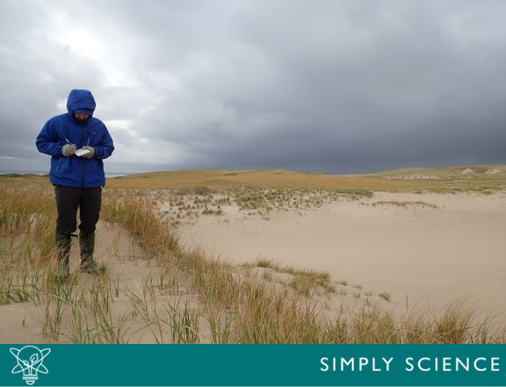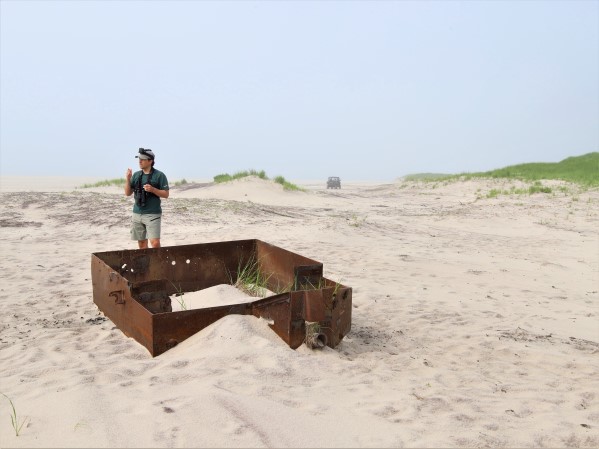March 2021
Sable Island is a truly unique microenvironment that’s been shaped and reshaped by changing sea levels, ice sheets, strong winds and waves for at least 10,000 years. It’s well known for its thriving wild horse population and one-of-a-kind wildlife. And now, scientists from Natural Resources Canada (NRCan) and Parks Canada are working together to understand how the wild forces of nature influence this shapeshifter.

Dan Kehler, a monitoring ecologist from Parks Canada
Jordan Eamer, a research scientist with the Geological Survey of Canada - Atlantic, is studying coastal erosion. The questions are many and important: How are the shorelines changing? Is one retreating while another one is advancing? What about the impact of climate change? His findings could provide valuable clues to help protect against coastal erosion elsewhere.
The Island is protected by the National Park Reserve and is a noted Important Bird Area. Dan Kehler, a monitoring ecologist from Parks Canada, is therefore exploring things from a different point of view, with questions like: Will this park be here in the future? How will the shifting sands affect wildlife and conservation efforts? What happens if the currents shift due to climate change?
Here’s a closer look at life on Sable Island:
Three dramatic views of Sable Island showing unique geographical features including a sandbar and layers of sand.
On approach and from above
Nearly 300 kilometres from Halifax, Nova Scotia, Sable Island first appears as a spit of sand, 40 kilometres long and a mere 1.2 kilometres across at its widest point. Access is mainly via a seven passenger Britten Norman Islander fixed-wing aircraft, but also occasionally by helicopter or the larger Twin Otter. Strong winds and ocean currents blast the island from both the east and the west, resulting in richly patterned layers of sand or sorted sediment.
Research scientist Dr. Jordan Eamer and student Sara Solaimani-Baghainia setting up monitoring gear; a group of researchers looking at the grassy landscape; and the living quarters at sunset.
The forces of nature
You don’t have to look far to see evidence of the powerful force of nature. Sable Island has long been a destination for scientists trying to understand the push and pull of the ocean and to observe truly unique species in the wild, like the more than 400,000 grey seals — the largest colony on the planet — and the endemic Sable Island Sweat Bee, known to occur only on the island. Jordan and Dan’s research builds on the large body of scientific knowledge that’s been collected and disseminated for decades by a wide range of scientists, naturalists and enthusiasts, including NRCan geoscientists and other federal government department research teams.

Sable Island history includes wild horses, endless grassy dunes and unusual beachside debris. This is the remains of a rocket gun used to propel a line to a foundering ship, built on a Second World War Bren gun carrier chassis.
History, wild horses, shipwrecks and debris
Sable Island is rich in history. It’s believed merchants brought the famous Sable Island horses here in the 1700s, but the Island was too remote for trade so the merchants moved on and left the horses behind. It’s also rich in atmosphere. With the cold Labrador Current on one side and the warmer Gulf Stream on the other, Sable is the foggiest place in the Maritimes. And it’s rich in human drama on the sea. More than 300 shipwrecks have occurred here, with most recently a passenger yacht running aground and breaking apart in 1999.
Scenes of Sable Island sand dune blowouts and shoreline erosion.
Blowouts and shorelines
The island is almost entirely composed of sand, sand dunes and wispy grasses. Evidence of blowouts — where wind continuously erodes the sand in saucer or trough-like shapes — and a mobile shoreline show an island that’s constantly changing. As for future changes, Jordan’s modelling suggests that rising sea levels could contribute to more rapid shape shifting.
- Read:
Learn more about Jordan Eamer’s work on ResearchGate
More on Dan Kehler’s work on ResearchGate - Listen:
Simply Science Sable Island podcast - Explore:
Parks Canada on Facebook – Sable Island National Park Reserve
Parks Canada
The Sable Island Institute
Friends of Sable Island